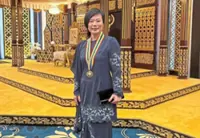Discovery of Kota Tampan, Lenggong, a 74,000-year-old site along early man’s migratory route from Africa to Australia. Photos: Prof Siti Zuraina Abdul Majid
She was the archaeologist who, in 1991, discovered the 74,000-year-old Palaeolithic stone tool site in Lenggong, Perak, alongside the world-famous 11,000-year-old Perak Man, which is the oldest human skeleton discovered in Malaysia.
Emeritus Professor Datuk Dr Siti Zuraina Abdul Majid was also responsible for obtaining UNESCO inscriptions for historical Melaka and George Town, Penang, and Batu Bersurat, Terengganu, which meant increasing the prestige of those sites and also raising awareness for its heritage preservation and conservation.
Already a subscriber? Log in
Save 30% OFF The Star Digital Access
Cancel anytime. Ad-free. Unlimited access with perks.





